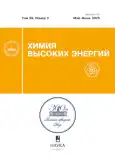Luminescence of polymer compositions doped with boron difluoride curcuminoids
- Authors: Shchelokov A.I.1,2, Zapol’skii A.E.2, Fedorenko E.V.1, Mirochnik A.G.1, Golik S.S.2
-
Affiliations:
- Institute of Chemistry, Far Eastern Branch of the RAS
- Far Eastern Federal University, Russky Island
- Issue: Vol 59, No 3 (2025)
- Pages: 160-166
- Section: MOLECULAR PHOTONICS
- URL: https://modernonco.orscience.ru/0023-1193/article/view/685824
- DOI: https://doi.org/10.31857/S0023119325030046
- EDN: https://elibrary.ru/aqvnen
- ID: 685824
Cite item
Abstract
Polymer luminescent compositions based on polystyrene and polycarbonate doped with symmetrical and asymmetrical curcuminoids of boron difluoride were obtained. The effect of substituents in dye molecules, polymer matrix and phosphor concentration on the spectral properties of polymer composites was studied. With an increase in the electron-donor effect of substituents, a bathochromic shift of the luminescence maxima of symmetric and asymmetric phosphors is observed. Positive solvatochromism for boron difluoride curcuminoids in polymers manifests itself for asymmetric curcuminoids. For films, a bathochromic shift of luminescence is observed with an increase in the phosphor concentration from 0.01 to 0.5%. In a PC film doped with a symmetric dye with a methoxy group, delayed fluorescence due to the formation of excimers was detected at room temperature.
Full Text
About the authors
A. I. Shchelokov
Institute of Chemistry, Far Eastern Branch of the RAS; Far Eastern Federal University, Russky Island
Author for correspondence.
Email: shchelokov.ai@dvfu.ru
Russian Federation, Vladivostok; Vladivostok
A. E. Zapol’skii
Far Eastern Federal University, Russky Island
Email: shchelokov.ai@dvfu.ru
Russian Federation, Vladivostok
E. V. Fedorenko
Institute of Chemistry, Far Eastern Branch of the RAS
Email: shchelokov.ai@dvfu.ru
Russian Federation, Vladivostok
A. G. Mirochnik
Institute of Chemistry, Far Eastern Branch of the RAS
Email: shchelokov.ai@dvfu.ru
Russian Federation, Vladivostok
S. S. Golik
Far Eastern Federal University, Russky Island
Email: shchelokov.ai@dvfu.ru
Russian Federation, Vladivostok
References
- Kamada K., Namikawa T., Senatore S. et. al. Boron difluoride curcuminoid fluorophores with enhanced two-photon excited fluorescence emission and versatile living-cell imaging properties // Chem. Eur. J. V. 22. P. 5219–5232.
- Ni R. et al. In-vitro and in-vivo characterization of CRANAD-2 for multi-spectral optoacoustic tomography and fluorescence imaging of amyloid-beta deposits in Alzheimer mice // Photoacoustics. 2021. V. 23. P. 100285.
- Laali K.K. et al. Fluoro-curcuminoids and curcuminoid-BF2 adducts: Synthesis, X-ray structures, bioassay, and computational/docking study // J. Fluor. Chem. 2016. V. 191. P. 29–41.
- Zhao J. et al. Mechanofluorochromism of difluoroboron β-ketoiminate boron complexes functionalized with benzoxazole and benzothiazole // Dyes and Pigments. 2018. V. 149. P. 276–283.
- Jiménez R. et al. Thermochromic and acidochromic properties of polymer films doped with pyridyl-β-diketonate boron (III) complexes // Dyes and Pigments. 2020. V. 177. P. 108272.
- Zhai L. et al. New non-traditional organogelator of β-diketone-boron difluoride complexes with terminal tetraphenylethene: Self-assembling and fluorescent sensory properties towards amines // Dyes and Pigments. 2017. V. 145. P. 54–62.
- Kammler R. et. al. Second-order optical non-linearity of new 1,3,2(2H)-dioxaborine dyes // J. Chem. Soc. 1996. P. 945–947.
- Shao G. et al. A new europium(III)-β-diketonate complex based on diphenylethyne as red phosphors applied in LED // J. Lumin. 2013. V. 138. P. 195–200.
- Shao G. et al. Diphenylethyne based β-diketonate europium(III) complexes as red phosphors applied in LED // Sens Actuators B Chem. 2012. V. 173. P. 692–697.
- Mohammed F., Rashid-Doubell F., Cassidy S., Henari F. A comparative study of the spectral, fluorometric properties and photostability of natural curcumin, iron- and boron- complexed curcumin // Spectrochim. Acta, Part A. 2017. V. 183. P. 439–450.
- Mirochnik A.G., Puzyrkov Z.N., Fedorenko E.V. et al. Fluorescent boron difluoride curcuminoides as perspective materials for bio-visualization // Spectrochim. Acta, Part A. 2023. V. 291. P. 122319.
- Kerr C., DeRossa C., Daly M. et al. Luminescent Difluoroboron β-Diketonate PLA-PEG Nanoparticle // Biomacromolecules. American Chemical Society. 2017. V. 18. № 2. P. 551–561.
- Liu Y. et al. An insight into the in vivo imaging potential of curcumin analogues as fluorescence probes // Asian J Pharm Sci. 2021. V. 16. № 4. P. 419–431.
- Collot M. Recent advances in dioxaborine-based fluorescent materials for bioimaging applications // Materials Horizons. 2020. V. 8. P. 501–514.
- Martins M.G., Paiva T.F., Goulart J.S. et al. Development of a fluorescent PMMA-based polymer material through in-situ incorporation of curcuma extract // Polym. 2023. V. 273. P. 125870.
- Ma. Q., Zhang Y., Jiao Y. et al. New β-diketone-boron difluoride based near-infrared fluorescent probes for polarity detection // Analyst. 2021. V. 146. № 19. P. 5873–5879.
- Xu S. et al. Aromatic Difluoroboron β-Diketonate Complexes: Effects of π-Conjugation and Media on Optical Properties // Inorg. Chem. 2013. V. 52. № 7. P. 3597–3610.
- Khrebtov A.A., Fedorenko E.V., Mirochnik A.G. Laser activated room-temperature excimer delayed fluorescence of difluoroboron β-diketonate complexes in polymer matrix // Polym. 2022. V. 256. P. 125255.
- Shchelokov A.I. et al. Studying the Spectral Properties of Luminescent Polymer Composites Doped with Boron Difluoride Curcuminoids // High Energy Chemistry. 2024. V. 58. № 5. P. 486–491.
- Weissberger A. et al. Organic Solvents. Physical Properties and Methods of Purification. 1955. 552 p.
- Fedorenko E.V. et al. Fluorescence and phosphorescence of α- and β-isomers of boron Difluoride naphthaloylacetonates // J. Photochem. Photobiol. A Chem. 2021. V. 412. P. 113220.
- Буквецкий Б.В., Федоренко Е.В., Мирочник А.Г. Кристаллическая структура и люминесценция 2,2-дифторо-4-(4′-фенилфенил)-6-метил-1,3,2-диоксаборина // Журнал структурной химии. 2010. С. 785–789.
- Khrebtov A.A. et al. Self-Absorption Effect in Polymer Films Doped with Difluoroboron β-Diketonates // Russian Journal of Physical Chemistry A. 2022. V. 96. № 8. P. 1800–1804.
- Kim E., Felouat A., Zaborova E. et. al. Borondifluoride complexes of hemicurcuminoids as bio-inspired push–pull dyes for bioimaging // Org. Biomol. Chem. 2016. V. 14. № 4. P. 1311–1324.
- Stefan B., Pozgan F., Kim E. et. al. Ethynylene-analogues of hemicurcuminoids: Synthesis and ground- and excited properties of their boron difluoride complexes // Dyes and Pigments. 2017. V. 141. P. 38–47.
Supplementary files












